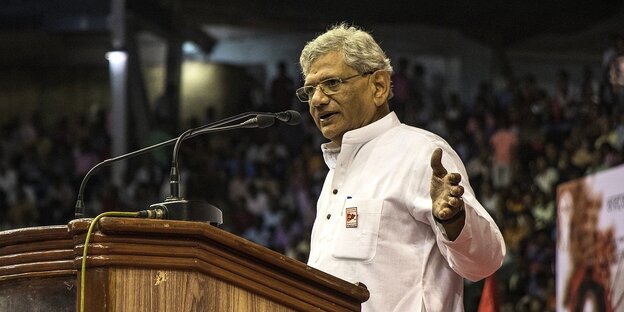Sitaram Yechury, general secretary of the Communist Party of India, on socialist politics in the country. Election success is not the only way.

Sitaram Yechury at a Marxist Communist Party of India event in Kolkata, West Bengal Photo: Amlan Biswas/Pacific Press Agency/imago
taz: Mr. Yechury, India once had a strong left-wing movement, but today it exists almost exclusively in the southern state of Kerala. Can you explain it?
Sitaram Yechury: Since the 1950s, the communist movement has been deeply rooted in Kerala, initially as part of the anti-colonial struggle against British rule until 1948. Therefore, the links between the communist movement and the freedom struggle are deep, making Kerala a state the most advanced. an important center to this day of leftist ideology and mass movements. West Bengal also remains a left-wing state, but we are not in a position to demonstrate this at the ballot box like we did in Kerala.
There are currently national elections in India. What is the impact of greater left-wing representation in the Indian Parliament?
The Indian population could benefit from a greater presence as the legislature succeeds. In 2004 there were 61 left-wing MPs. At that time, important laws such as the right to access information, guaranteed minimum working days, and indigenous rights were introduced.
How did demographic changes in India affect the communist movement?
This requires adaptability, because today's employees work more in sectors such as IT and services. Our work must reflect these changes: once it was only union work, today our movement is much broader.
71, was general secretary of the Marxist-Communist Party of India CPI(M) and a member of its political bureau since 1992. From 2005 to 2017 he sat in the upper house of the Indian Parliament
What influence have left-wing forces had on Indian politics?
To understand the importance of the Left or PKI (M), two standards are needed: First, the election results that left us behind. Second, the ability to set the state agenda through mass movements. Here the influence of the left is increasing. If you look at the last few years, the biggest mass movement was the Indian farmers' movement in 2020-21, in which the Left played a very important role. Prime Minister Modi's government was forced to roll back the farm laws – something that had never happened before. For these reasons, the government views left-wing groups as responsible for mobilizing workers against the ongoing privatization of the country in the interests of large corporations.
Has there been any further success?
When the incumbent government tried to legitimize political corruption through anonymized electoral bonds, it was the CPI(M)'s petition that was allowed by the Supreme Court as the party had not received any of the electoral bonds. Shortly after its introduction in 2018, we filed a lawsuit in court. India's legal system took six years to reach a decision: electoral bonds were unconstitutional and courts demanded that the names of party donors be disclosed.
The opposition has benefited from this reassessment. But why are regional left-wing parties like the CPI(M) and the more liberal Congress party fighting each other in India?
In Kerala, the Left and Congress parties competed in the elections mainly to prevent the right-wing ruling party, the BJP, from gaining support. This strategic confrontation ensures that the BJP remains marginalized in Kerala.







